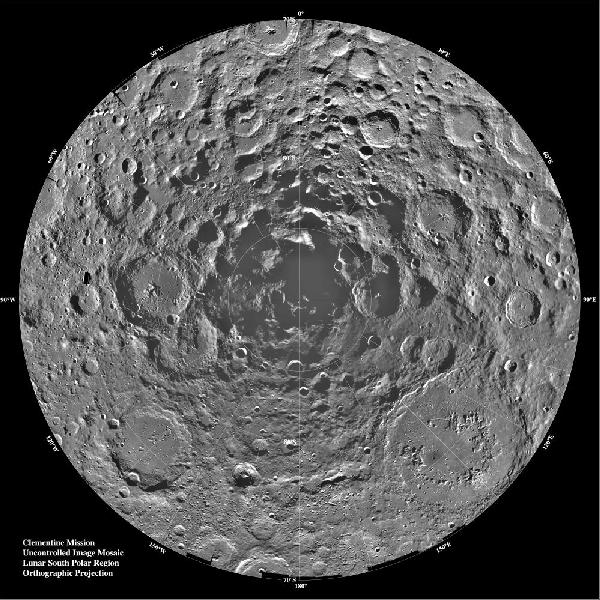


Rough Notes:
The Moon’s southern latitudes. Credit: NASA/Clementine Mission
Mar 28, 2008
The South Lunar Pole
Future manned missions to the Moon are slated to land in the polar regions because large deposits of water are thought to exist there.On January 25, 1994, NASA launched the Deep Space Program Science Experiment satellite,Clementine, with a dual mission objective: map the surface of the Moon in visible and ultraviolet light and then leave the lunar environment for a rendezvous with the Near Earth Object (NEO), 1620 Geographos, a five-kilometer-long asteroid that occasionally crosses orbits with our planet. Unfortunately, a rocket booster became stuck in the “on” position after Clementine left the Moon, causing it to spin wildly out of control and exhaust its fuel supply.
Shortly after the mission data was analyzed, scientists announced that the south pole of the Moon contained pockets of water ice shielded from the Sun by shadows cast from the walls of deep craters and by a covering of insulating rocks and dust. This announcement sparked a renewed interest in lunar colonization, because the abundant water could be a source of hydrogen.
Establishing a base on the Moon has been the ultimate goal of lunar exploration since the 1960s when the United States put the first human beings there. For forty years, that goal has been held in abeyance because of cost and scaling problems. In order to provide a small band of explorers with life support while they conduct their surveys on the surface, the space vehicle would have to be enormous.
Just to construct a cargo transporter that can carry the oxygen, food and water for an extended stay is beyond our current technology. Blasting such loads into space would mean building something ten times the size of the old Saturn V system – a project too costly to contemplate even if it was technically feasible.
When Clementine supposedly detected water ice on the Moon it was thought that the solution to one of the major obstacles to a moon base had been found. Water can be split into oxygen and hydrogen by applying electricity, therefore solar panels could be transported to the Moon and used to create breathable air, potable water and fuel to power the machinery. Also, some areas of the south pole might be in permanent sunshine so a continuous energy source would be available to crack the ice into its constituents and keep the colony powered up.
A team of researchers has questioned the accuracy of Clementine’s data and suggested that the instruments may have seen reflections off the steep sidewalls of deep craters and not the signature of ice deposits. Since the radar signature came from both brightly illuminated and darkly shaded areas of Shackleton crater, the reflection probably came from rocks and other debris rather than ice. As Donald Campbell wrote in the science journal Nature:
"Any planning for future exploitation of hydrogen at the Moon's South Pole should be constrained by this low average abundance rather than by the expectation of localised deposits at higher concentrations."
Ice on the Moon could have come from cometary fragments over millions of years, according to conventional theories. Comets and asteroids supposedly hit the Moon by the million early in its history. The objects that formed Shackleton crater and the rugged topography in the south left behind great loads of water vapor that quickly condensed and precipitated on the cold walls of the craters after the impacts. The frozen water vapor was protected from sublimation when the dust thrown out by the explosions settled back to the surface, covering over the ice and compressing it.
As we have written in past Picture of the Day articles, the search for water on the Moon is most likely a forlorn hope. The Moon does not present features caused by innumerable strikes from high-velocity space rocks or thousands of comets out of a hypothetical Oort Cloud. Rather, lunar structures and terrain are the result of powerful electric discharges at some time in the relatively recent past.
Physicist and Electric Universe pioneer Ralph Juergens wrote the following:
“Explaining a crater floor of bare, once-molten rock in terms of the conventional impact theory is a little difficult. One must resort to ad-hoc theorizing to the effect that something – perhaps the shock of the postulated impact explosion – melted a considerable volume of rock at some depth, and that following the explosion this material welled up to engulf the crater floor and flow around obstructions encountered there; otherwise, debris from the explosion itself could be expected to clutter the crater floor. Impact theory offers no reason, however, to expect such a sequence of events, and nothing in terrestrial experience with crater-producing explosions supports the idea.
“...Though an electric discharge might be thought of as taking place in a very brief span of time, an interplanetary discharge must surely be an event of greater duration than an impact explosion; the long- distance flow of current would persist beyond the instant of any initial touchdown explosion, and ejecta that chanced to fall back into the crater thus produced could be swept away or melted in place.”
The morphology of the Moon – and the south pole in particular – is indicative of the features Juergens described. No water-bearing impactors formed the terrain there. Rather, it was electricity that carved the Moon and any water that might have once existed was obliterated by the energy released in the event.
By Stephen Smith